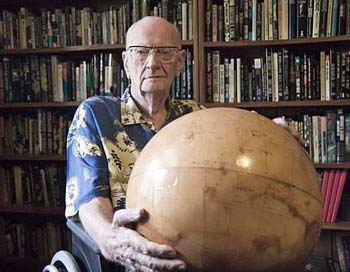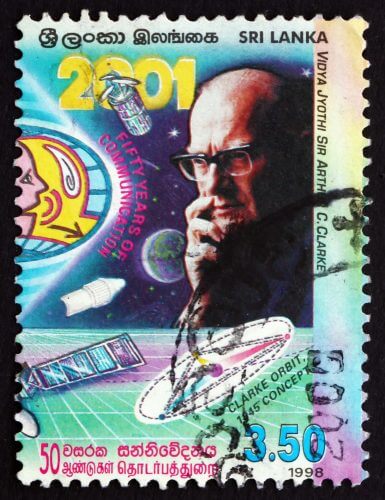In March of this year, Sir Arthur C. passed away. Clark, one of the greatest science fiction writers. In this article we will review Clark's world, and especially his well-known masterpiece - "2001: A Space Odyssey."

In 1964, two giants met, and decided to create a movie and a book together. The first giant came from the world of cinema, and his name was Stanley Kubrick - the successful director behind the famous 'A Clockwork Orange'. The other giant was Arthur C. Clark, who is today considered one of the greatest writers of the Middle East.
Kubrick wanted to make a fine science fiction film, and a friend suggested he contact Clark, already a famous writer at the time. Clarke, originally British, lived in Sri Lanka - a fact that made Kubrick believe that Clarke was a loner and a bit psychotic, but did not prevent him (and maybe even encouraged him, who knows) to approach the writer and offer him to work together on the film.
In the story, astronauts discover a monolith, a smooth block of black rock placed on the lunar soil by a highly advanced civilization as an 'alarm' to alert when human civilization is advanced enough to allow interstellar travel. In the movie version, the story continues with a research spaceship's journey to Jupiter whose goal is to discover the destination to which the monolith is transmitting (in the book version, they travel to Saturn). The journey goes wrong when the spaceship's computer loses its mind and tries to eliminate the crew members, and ends when the film's hero, astronaut Dave Bowman, passes through a 'gate between stars' and becomes acquainted with the advanced civilization.

In the film, the scene of uncovering the monolith takes place in an excavation inside Tycho Crater, a prominent and young crater on the surface of the Moon. The studio where the film was shot was specifically chosen because it was the only studio large enough to accommodate the set for this scene. This was not the only challenge in terms of the special effects in the film, and Kubrick's attention to the small details caused the shooting to be extended over a year after the planned date, and the cost grew almost twice.
Kubrick, influenced by Clarke and contrary to the accepted trend in Hollywood, tried to maintain maximum realism in the film. All the scenes located in empty space are completely silent, and those who have seen the film will not be able to forget the fascinating representation of the artificial gravity inside the spaceship, created by the rotation of the spaceship's body around itself, a rotation that creates a centrifugal force that pushes the astronauts standing on the sides of the spaceship outward. Clarke and Kubrick were helped in the planning of this scene by the most distinguished consultants: Neil Armstrong, the first man on the moon, and the cosmonaut Alexey Leonov, who performed the first spacewalk in history.
But small mistakes are, of course, inevitable. When Dave Bowman realizes that the air is being sucked out of the spacecraft, he takes air into his lungs to prepare for the approaching vacuum. For the information of any of the readers who will encounter this situation in the future, I would advise: do not try this at home. NASA instructs its astronauts to empty their lungs of air, to prevent the gas from spreading inside the body and tearing the lungs. Clarke later claimed, had he been on set that day of filming, he would have corrected that little mistake on the spot.
2001: What the Movie Predicted and What Happened in Reality

Clarke was always known as a writer of 'hard' science fiction, one in which science and realism took a significant place in his stories. But specifically Odyssey in Space, and later also the book 'Meeting Rama', emphasize a certain contradiction in Clark's personality. A very important motif in his works is the idea that there is a highly advanced being or culture that monitors the progress of humanity and helps it from time to time. This entity is not 'God' in the religious sense of the word, but in its attributes and influence on humanity there is much resemblance to the concept of divinity. Clarke solved this dilemma in one of his most immortal and famous sentences: "Any sufficiently advanced technology is indistinguishable from magic." Clark was not a spiritual type, or as he himself defined it: "I don't believe in astrology. I'm a Sagittarius, and we're skeptical types."
When A Space Odyssey was released, the response from critics was mixed, but history has judged the film to be a masterpiece, without a doubt. The famous opening of the human ape crushing the skull of his opponent against the background of Richard Strauss's classic work, the rotating space station against the background of the mesmerizing music of Johann Strauss, and of course the unforgettable scene where Dave Bowman neutralizes God 9000, the ship's unruly computer - these are cinematic moments No science fiction fan will be able to protest after seeing the movie.
Interview with Arthur C. Clark since 1992
The last scene I mentioned, the disintegration of God 9000, is partly the result of an interesting experience that Arthur C. Clark when he visited Bell Labs two years earlier. A friend took him for a tour of the labs and there they met the scientist John Larry Kelly, who was working on computer voice synthesis technologies - in other words, how to make a computer talk. Kelly demonstrated to the two his computer, an IBM 704, reciting the children's song 'Bicycle for Two', with musical accompaniment. This experience left such a deep impression on Clarke that he insisted Kubrick include it in a scene in the film.
But also a famous scientist and writer like Arthur C. Clark was not immune to scandals. The fact that he moved to live in Sri Lanka in the mid-XNUMXs was so unusual that it never ceased to arouse the curiosity of investigative journalists. Clark said that he decided to move to the small country south of India because he wanted to enjoy his main hobby, diving, but the question always hung in the air as to whether this was indeed the only reason for Clark's move to Sri Lanka. In particular, the fact that Clark was a staunch bachelor (except for a brief marriage that lasted only six months) and was, apparently, an openly gay man, raised doubts.
In 1998, the British tabloid 'Sunday Mirror' dropped an amazing bombshell. A day before Clarke was to receive a British knighthood, the highest honor this great empire can bestow on its citizens, the tabloid published an article claiming that Clarke is a pedophile, a rapist and a 'child predator' in the full sense of the word. The article claims that Kalrak moved to Sri Lanka because there, in the lawless third world country, he could exercise his deviant desires without fear.
This article caused a great stir in Britain, but no one had any intention of canceling the awarding of the title to Clark because of an article in a British tabloid.
But Clark himself insisted on not receiving the knighthood until his name was cleared. The local police in Sri Lanka launched an investigation, which eventually cleared Arthur C. Clark cleared of all suspicions towards him, and only then did he agree to receive the knighthood, two years late. The cynics claim that the Sri Lankan authorities had every reason in the world to protect the country's national and cultural symbol. Clark's friends and admirers see the entire pedophilia story as further evidence of the boundless wickedness of the British tabloids.
About eight years ago, in an interview with the BBC, Clark indicated the four biggest threats in his opinion to the future of the human race: "global warming, environmental pollution, an asteroid impact on the Earth and a burst of gamma rays."
We have heard and read a lot about the first three threats. The fourth threat Clark raised in the interview - a burst of gamma rays - has received very little media attention compared to the others, but Clark knows what he's talking about. A gamma ray burst is a massive burst of powerful radiation that originates in outer space. This is a rare phenomenon in itself - but due to the size of the universe, it occurs with daily frequency. A burst of gamma rays lasts no more than a few seconds to minutes, but releases energy in a truly unimaginable amount: in fact, no cosmic phenomenon since the Big Bang has released energy with such a massive intensity.
The scientists hypothesize that most of these bursts of radiation occur when very massive stars use up their nuclear fuel supply. When the nuclear processes are over, the cores of the stars collapse and form black holes or neutron stars. During the collapse, the intense burst of high-energy gamma radiation is released.
Fortunately, all gamma ray bursts detected so far have occurred very far away from us, outside the Milky Way galaxy. If such an event were to occur even a few thousand light years away from us, we would be in deep trouble. The intensity of the radiation would have been sufficient to destroy the entire ozone layer in the hemisphere that was directed towards the source of the explosion at that moment, and the ultraviolet radiation from the sun would have eliminated most of the living things on Earth. A burst of gamma rays in an environment even closer to us, say a few hundred light years from here, would simply blow our atmosphere into space and melt the top layer of the earth.
Clarke was right when he said in an interview that a burst of gamma rays near the Earth would wipe out humanity. Scientists are currently investigating the possibility that such events are responsible for some of the mass extinctions that have occurred in Earth's history.
Maybe it's cosmic irony, maybe just a strange coincidence, but on March nineteenth of this year, the night Arthur C. Clark passed away, captured by the Swift satellite of the American space agency, NASA, An extremely intense gamma ray burst – An outburst that was named the 'Clark incident'. This burst broke all previous records, and its intensity was two and a half million times more powerful than any recorded supernova in history. It is the most luminous object observed by humans in the universe, and it occurred at a distance of about seven and a half billion light years. Had it taken place in the Milky Way galaxy, near Earth, it would have fulfilled all of Arthur C.'s fears in its destruction. Clark.
(The article is taken from the program 'Making history!', A bi-weekly podcast about science, technology and history)
